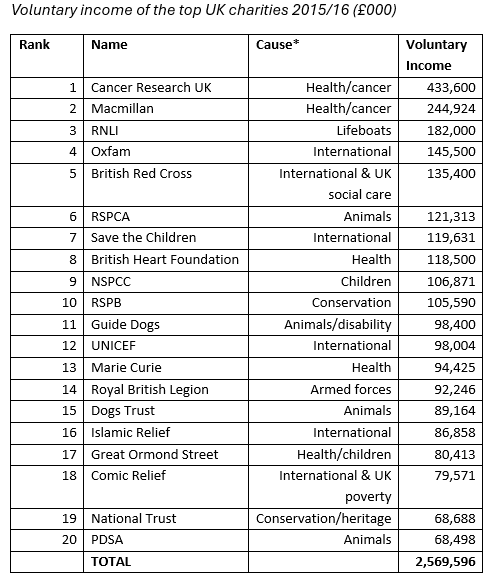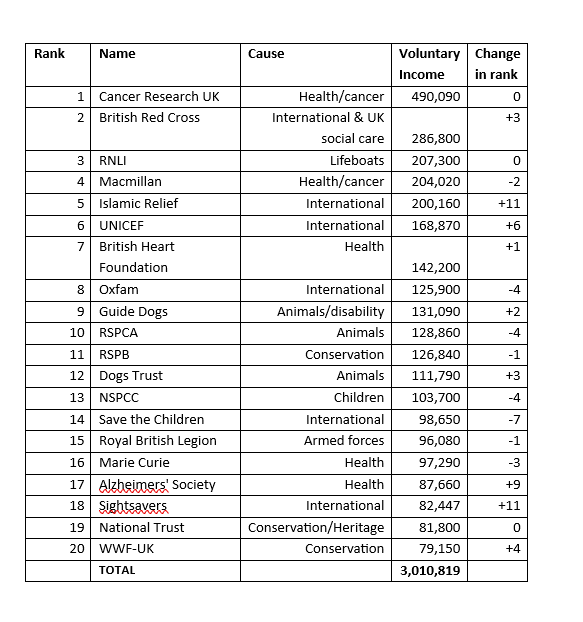How Has Fundraising Changed Since 2016?
Tobin Aldrich
4th April 2024
Anybody who has ever tried to benchmark the fundraising performance of charities against each other will tell you it is a thankless and frustrating task. Charities are absolutely excellent at reporting their income and expenditure in confusing and inconsistent ways and the task of comparing apples to apples is, well, an interesting one.
So obviously we spend quite a lot of time and energy on benchmarking. It’s pure masochism really.
Amongst all the pain and suffering we do occasionally manage to collect interesting data so I’d thought I’d share some of this.
Since 2017 we have been tracking the overall fundraising performance of the top 100 UK charities by voluntary income. This is using public data only (although we have worked with a majority of these organisations in some capacity, we obviously can’t share their information) which means using the audited accounts each charity files with the Charity Commission.
Given that every charity uses the same accounting framework (SORP), you’d have thought this means that this would be a simple task. You would be wrong, there is wide room for interpretation in these principles and boy do charities take advantage of it. How and why is a whole different subject but for now let’s just say we have to do quite a bit of work on these figures to make them reasonably comparable.
That all being said, in 2015/16 (year ending before April 2016) the organisations below were, according to our figures, the top charities in the UK by fundraised income (that is to say donations and legacies from individuals, charitable trusts and companies).
*These are our definitions based on what section of the fundraising “market” we think the charity occupies, not how the charity would represent themselves (sorry Guide Dogs).
Of the top 20 charities, five were in the health sector, including the two big cancer charities CRUK and Macmillan which were first and second in the top 20. There were six internationally focused charities (if we classify Red Cross and Comic Relief as international), four animal charities, two conservation/heritage and a smattering of others.
Going forward to the year ending before April 2023, there has been quite a lot of change. CRUK retains the top spot but there’s plenty of movement below this. This was the year of the Ukraine appeal, so we have internationally focused charities - BRC, Islamic Relief and UNICEF – performing strongly and moving up the chart, but all of these had been growing even before this. Sightsavers, which is not an emergency charity, has entered the top 20, up 11 places since 2015/16.
Not all international charities have grown, Oxfam has fallen from 4th to 8th place while Save the Children has gone down from 7th to 14th place.
Health charities remain strongly represented, but there are winners and losers. Macmillan is down to 4th from 2nd place. Marie Curie is down three spots. BHF is up one place and Alzheimers has entered the top 20, up nine spots from 2016.
Animal charities are still strongly represented but there has been a bit of movement between them. Conservation charities are showing growth, WWF are up four places for example.
What does all this tell us?
Well let’s start with the macro picture. The voluntary income of the top 20 charities in 2015/16 was £2.56bn and this had grown to £3bn by 2022/23. That’s a 19% increase in seven years. That sounds good except that, according to the Bank of England, the Consumer Price Index has increased by 30% in that period. The situation is worse if we exclude legacies. Donation income of the top 20 increased by just 12% in seven years.
There’s some movement between causes. In a year when there was a once-in-a-generation emergency appeal for Ukraine, we saw some strong results for some international charities but this overlays a pattern of steady decline by some long established international development charities. Children’s charities are steadily losing market share - the highest ranked children’s charity is now outside the top 10 charities. Conservation is growing, animals and health are broadly stable.
Oh and the fifth biggest charity by voluntary income in the UK is Islamic Relief. Now that’s a societal shift right there.
This is very much just the edited highlights of our data, which cover the top 100 charities. If anyone wants more of the underlying detail, just drop me a line.


